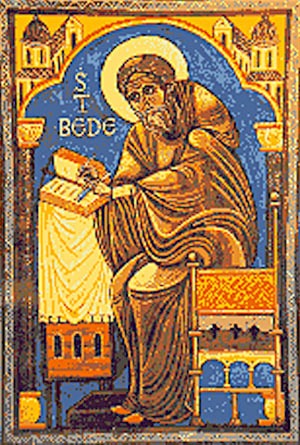“Full in the midst of this infernal Road, An Elm displays her dusky Arms abroad; The God of Sleep there hides his heavy Head And empty Dreams on ev’ry Leaf are spread. Of various Forms, unnumber’d Specters more; Centaurs, and double Shapes, besiege the Door: Before the Passage horrid Hydra stands, And Briareus with all his hundred Hands: Gorgons, Geryon with his triple Frame; And vain Chimæra vomits empty Flame. The Chief unsheath’d his shining Steel, prepar’d, Tho seiz’d with sudden Fear, to force the Guard. Off’ring his brandish’d Weapon at their Face, Had not the Sibyl stop’d his eager Pace, And told him what those empty Phantoms were; Forms without Bodies, and impassive Air.”
p. 17
even though Neo-Platonism was to intervene and many centuries pass before this emphasis took definite form.
Although Ammonius Saccus was long believed to be the founder of Neo-Platonism, the school had its true beginning in Plotinus (A.D. 204-269?). Prominent among the Neo-Platonists of Alexandria, Syria, Rome, and Athens were Porphyry, Iamblichus, Sallustius, the Emperor Julian, Plutarch, and Proclus. Neo-Platonism was the supreme effort of decadent pagandom to publish and thus preserve for posterity its secret (or unwritten) doctrine. In its teachings ancient idealism found its most perfect expression. Neo-Platonism was concerned almost exclusively with the problems of higher metaphysics. It recognized the existence of a secret and all-important doctrine which from the time of the earliest civilizations had been concealed within the rituals, symbols, and allegories of religions and philosophies. To the mind unacquainted with its fundamental tenets, Neo-Platonism may appear to be a mass of speculations interspersed with extravagant flights of fancy. Such a viewpoint, however, ignores the institutions of the Mysteries–those secret schools into whose profundities of idealism nearly all of the first philosophers of antiquity were initiated.
When the physical body of pagan thought collapsed, an attempt was made to resurrect the form by instilling new life into it by the unveiling of its mystical truths. This effort apparently was barren of results. Despite the antagonism, however, between pristine Christianity and Neo-Platonism many basic tenets of the latter were accepted by the former and woven into the fabric of Patristic philosophy. Briefly described, Neo-Platonism is a philosophic code which conceives every physical or concrete body of doctrine to be merely the shell of a spiritual verity which may be discovered through meditation and certain exercises of a mystic nature. In comparison to the esoteric spiritual truths which they contain, the corporeal bodies of religion and philosophy were considered relatively of little value. Likewise, no emphasis was placed upon the material sciences.
The term Patristic is employed to designate the philosophy of the Fathers of the early Christian Church. Patristic philosophy is divided into two general epochs: ante-Nicene and post-Nicene. The ante-Nicene period in the main was devoted to attacks upon paganism and to apologies and defenses of Christianity. The entire structure of pagan philosophy was assailed and the dictates of faith elevated above those of reason. In some instances efforts were made to reconcile the evident truths of paganism with Christian revelation. Eminent among the ante-Nicene Fathers were St. Irenæus, Clement of Alexandria, and Justin Martyr. In the post-Nicene period more emphasis was placed upon the unfoldment of Christian philosophy along Platonic and Neo-Platonic lines, resulting in the appearance of many strange documents of a lengthy, rambling, and ambiguous nature, nearly all of which were philosophically unsound. The post-Nicene philosophers included Athanasius, Gregory of Nyssa, and Cyril of Alexandria. The Patristic school is notable for its emphasis upon the supremacy of man throughout the universe. Man was conceived to be a separate and divine creation–the crowning achievement of Deity and an exception to the suzerainty of natural law. To the Patristics it was inconceivable that there should ever exist another creature so noble, so fortunate, or so able as man, for whose sole benefit and edification all the kingdoms of Nature were primarily created.
Patristic philosophy culminated in Augustinianism, which may best be defined as Christian Platonism. Opposing the Pelasgian doctrine that man is the author of his own salvation, Augustinianism elevated the church and its dogmas to a position of absolute infallibility–a position which it successfully maintained until the Reformation. Gnosticism, a system of emanationism, interpreting Christianity in terms of Greek, Egyptian, and Persian metaphysics, appeared in the latter part of the first century of the Christian Era. Practically all the information extant regarding the Gnostics and their doctrines, stigmatized as heresy by the ante-Nicene Church Fathers, is derived from the accusations made against them, particularly from the writings of St. Irenæus. In the third century appeared Manichæism, a dualistic system of Persian origin, which taught that Good and Evil were forever contending for universal supremacy. In Manichæism, Christ is conceived to be the Principle of redeeming Good in contradistinction to the man Jesus, who was viewed as an evil personality.

Moe is the founder of GnosticWarrior.com. He is a father, husband, author, martial arts black belt, and an expert in Gnosticism, the occult, and esotericism.


